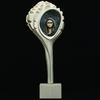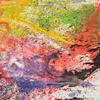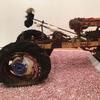Representations of Paleolithic Female Figures Featured in Yale Peabody Museum Exhibit
- NEW HAVEN, Connecticut
- /
- August 13, 2018

“The Artist’s Eye: Figurines of the Paleolithic,” an art exhibition featuring sculptures by Cornelia Kubler Kavanagh that pay homage to some of the first three-dimensional representations of the female form ever discovered, opened Aug. 11 at the Yale Peabody Museum of Natural History.
The exhibition, on view through March 17, celebrates Upper Paleolithic hunter-and-gatherer artisans who created the female figures 100 generations ago, between 40,000 and 15,000 BCE.
Some 200 of these figures were discovered, some in association with weaponry, jewelry, and animal remains, at archaeological sites from southwestern France to Siberia. Most were found in farmers’ fields or in early excavations when archaeological methods were imprecise and less sophisticated than today.
The exhibition asks, “Can artistic interpretation and scientific investigation co-exist?” The answer is a resounding “yes” as the goal of archaeologist and artist alike is to “ponder the imponderable, to get into the mind of the long-dead creator,” says Roderick McIntosh, professor of anthropology at Yale.

“Being excited to wonder about the ineffable — daring to imagine that one human being might delve inside the mind of another human being who lived 100 generations ago — might just be the key to being human,” adds McIntosh, who is also curator-in-charge of anthropology at the Yale Peabody Museum.
Kavanagh, a New Haven-born artist, has been in awe of these figures since seeing the so-called “Venus of Lespugue” in Paris as a child. She began contemplating “how people living at the edges of glacial ice could produce such expressive sculpture with stone tools,” she says. She was also intrigued by how the figures evoke the sculpture of Modernists like Hans Arp, Joan Miró, and Henry Moore, who have long informed her work.
For the exhibition Kavanagh faithfully replicated 12 of the ancient figures, choosing polymer and bronze as her medium in lieu of the soft stone, bone, and ivory from which many of the originals were carved, or the clay from which some were formed and fired. Whereas the original figures ranged from 1.4 to 8.9 inches high, Kavanagh enlarged the scale of hers to make the surface details more visible.
She then placed them in seashells selected to complement each figure. Shells have not only informed Kavanagh’s own work but have long been associated with birth and regeneration. Each of the figures shown in its shell is a complete sculpture and can be compared with its original artifact.
The 12 artifacts providing inspiration for Kavanagh’s sculptures include:
- Hohle Fels. Excavated in 2008 from the Hohle Fels Caves of Schelkingen, Germany, and claimed by some to date as early as 40,000 BCE, this piece can only be roughly attributed to sometime before the early Solutrean (before c.24,000).
- Brassempouy. This head in mammoth ivory is purportedly from the Grotte du Pape in southwestern France. It is considered one of the finest pieces of the earliest Aurignacial (after 30,000 BCE). Her tiny triangular face bears an intense stare and pronounced brow but no mouth.
- Lespugue. This Gravettian (c. 25,000 BCE) piece from the Les Rideaux Cave in the Pyrenees is the figure that inspired Kavanagh as a child. Possessing the most pronounced features of all Upper Paleolithic figures, her enormous breasts, buttocks, belly and thighs are fashioned into a nest of eggs. Picasso purportedly kept two castings of her in his studio, considering her the “quintessential female form.
- Willendorf. Because of her enormous breasts, enlarged abdomen and ample buttocks, she is one of the most recognizable of Upper Paleolithic pieces. Willendorf lacks a secure date but the piece may possibly be late Gravettian (post-25,000 BCE).
Kavanagh is a daughter of George Kubler, who is considered one of the most influential art historians of the 20th century. Nurtured in an environment rich in the visual arts, her artistic consciousness was further developed by extensive travels and study in South America and Europe. She taught herself to carve stone in the Modernist tradition of Moore, Barbara Hepworth and Arp, eventually developing a signature style of her own characterized by rounded, sensual shapes. As demand for her sculpture increased, Kavanagh began carving maquettes out of polystyrene, finishing them with plaster for casting in bronze and aluminum. She has exhibited at the American Museum of Natural History, the Smithsonian’s National Museum of Natural History, and the Peabody-Essex Museum.
“The Artist’s Eye: Figurines of the Paleolithic” is open during regular museum hours: Tuesday through Saturday from 10 a.m. to 5 p.m., and Sundays from noon to 5 p.m. Entrance to the exhibition is free with museum admission; tickets can be purchased at the door or in advance on the Peabody website at a cost is $6 to $13. To purchase tickets, visit the Yale Peabody Museum website.

270x400_c.jpg)

10270x400_c.jpg)
__A270x400_c.jpg)
270x400_c.jpg)









5100x100_c.jpg)




